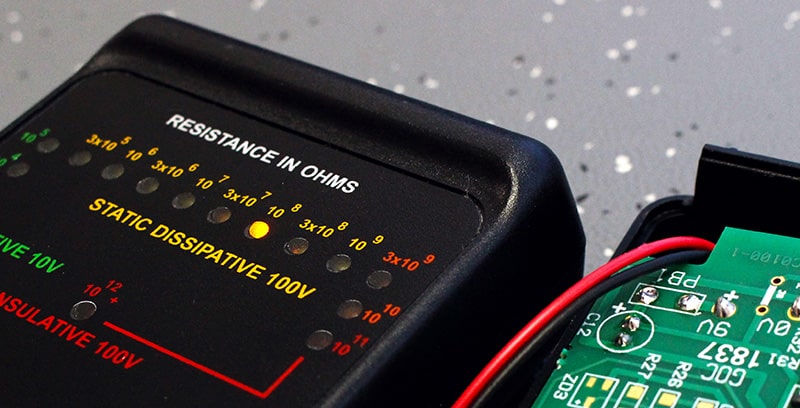A Trusted UK Supplier Of ESD Control Products Since 1986
A Trusted UK Supplier Of ESD Control Products Since 1986
An ESD (electrostatic discharge) compliance verification plan is an important aspect of the maintenance of an ESD Protected Area (EPA). It’s the best way to monitor and control safety-critical applications and eliminate the possibility of harm to static sensitive components. An effective ESD verification plan minimises ESD damage, protects your brand image and ensures compliance with legislation.
Here, we provide useful tips that will help you to create an ESD compliance verification plan and ensure that your EPA remains effective at all times:
The first step to developing a successful compliance verification plan is to audit your EPA and identify the equipment that needs to be tested on a regular basis. After all, ESD protection equipment will only prevent electrostatic discharge if it remains fully functional.
Whether you’re relying on an ESD user bench, grounding kit or ESD wrist bands to protect ESD-sensitive items, it’s important to test this equipment on a regular basis. By listing all of the ESD control items in use in your compliance verification plan, you can ensure that thorough testing, assessments and audits can be carried out.

Once you’ve created an inventory of the equipment in your EPA, determine how frequently each item needs to be checked and draft a testing schedule that can be easily implemented. Remember – the longer an item has been in use, the more frequently it should be checked, so do not forget to update your testing schedule periodically.
Although staff should be fully trained before conducting any testing, you’ll also need to specify which testing methodologies should be used in your ESD compliance verification plan. An earth lead will be tested differently to an ESD sticky mat or ESD flooring, for example, so your compliance verification plan should specify exactly how each item should be tested to ensure effectiveness and consistency.
There are reference testing standards that are typically used by any company or organisation with an EPA, but it is possible to use your own testing methodologies instead. However, you will need to justify why you have deviated from the objective reference testing standards if you choose to use your own custom methodologies.
Every ESD control item, such as an ESD chair, bench or even an ESD moisture barrier bag is subject to acceptable limits. Following the standard acceptable limits will ensure adequate ESD protection is maintained and reduce the risk of damage occurring within an EPA, which is why it’s important to include them in your ESD compliance verification plan. It’s worth noting, however, that acceptable limits may need to be adjusted based on a company’s unique requirements, so take this into consideration when integrating acceptable limits into your plan.
When testing ESD protective equipment, it’s essential that the testing equipment you use is up to standard. Our ESD wrist strap test station is compliant with ESD, CE, UKCA, RoHS and REACH standards, for example, so you can be confident that the tests carried out will be accurate and reliable.
Once you have appropriate testing equipment in place, be sure to clearly state which testing equipment should be used in your ESD compliance verification plan. This will prevent potential confusion and ensure that testers have a clear and unambiguous guide to follow when they are conducting testing in accordance with the plan.
Staff should be fully trained before they carry out testing in an EPA, which means that only particular employees will be able to undertake audits and assessments. With adequate on-site testing, you can ensure that staff are able to conduct effective and compliant testing, in accordance with your compliance verification plan. Furthermore, training more staff than you need will ensure that you always have access to employees who are equipped to carry out testing, which will prevent unnecessary disruption or operational delays.
When you create your ESD compliance verification plan, be sure to specify which employees are trained to carry out audits, assessments and testing and update this regularly if additional staff are certified. In addition to this, you may want to assign employees to testing phases to complete your testing schedule.
The results of ESD audits, assessments and testing should be fully recorded so that subsequent action plans are data-driven and justified. If records show that a particular piece of ESD control equipment has failed on numerous occasions, for example, the testing frequency can be increased, or the item can be replaced. By reviewing the outcomes of testing on a regular basis, companies can identify when action needs to be taken to preserve the integrity and effectiveness of the EPA.
While some EPA testing equipment automatically records the outcome of tests, this isn’t always the case. Whether you’re using a software-based platform or manually recording test outcomes, it’s important to include clear recording instructions within your ESD compliance verification plan.
When an audit or assessment has been undertaken, your ESD compliance verification plan should specify how the results will be shared with relevant parties, such as the staff working in your ESD protected area (EPA). Implementing a structured information-sharing process will ensure that employees are kept up to date regarding EPA functionality. Additionally, any issues of non-compliance can be addressed to improve the performance of your EPA. By including this information in your ESD compliance verification plan, it’s easy to ensure that this critical step is not overlooked.

An ESD compliance verification plan is essential for any organisation that handles ESD-sensitive items. With a comprehensive plan in place, you can reduce the risk of ESD-sensitive items being subject to damage and ensure that all staff working in your EPA adhere to appropriate protocols. This, combined with regular on-site ESD training, workstation signage and effective ESD control equipment will help to ensure your EPA functions optimally.
To learn more, explore our range of ESD testing equipment and discover how they can enhance your EPA assessments and audits now. Or, get in touch with our team for further help on how to create an ESD compliance verification plan by filling the form below.
On selected products if ordered before 1pm
Dedicated account manager to help your ordering process
Great value on premium quality products